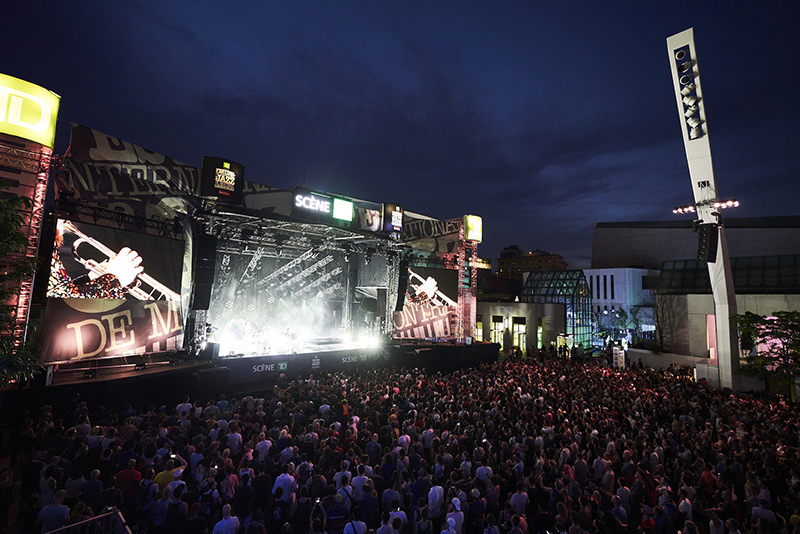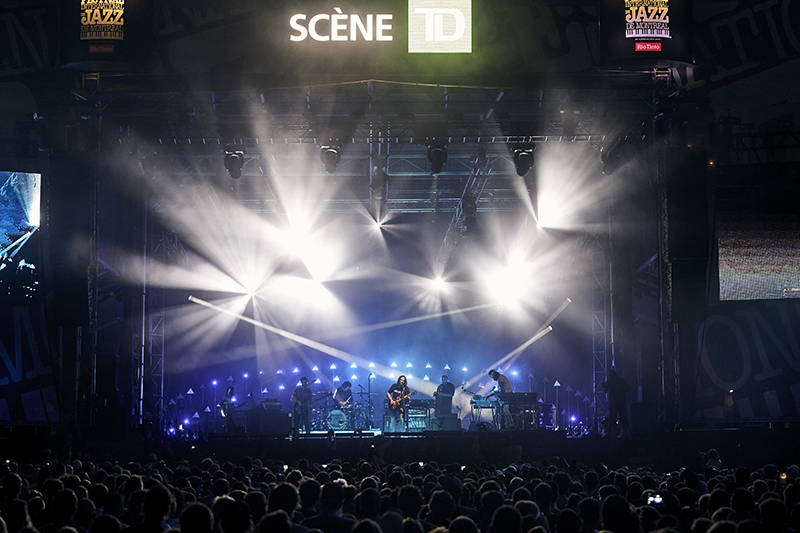
Stageline Sets the Stages During Another Busy Summer
The most popular event of its type in the world, the Montréal Jazz Festival (Festival International de Jazz de Montréal) is a 10-day musical extravaganza that explores a wider range of music than its title implies and lures in two million visitors annually. There is music emanating in the streets and throughout indoor venues large and small, and festivalgoers get to explore the Canadian city and indulge in its food and culture. This was my second time going for a three-day weekend, and it did not disappoint. Al Di Meola, Herbie Hancock, Bela Fleck and Flecktones, Lucieros, Elise LeGrow, and Marc Ribot headlined and, just by navigating through the crowd, I discovered some unexpected musical surprises.

By the Numbers
Some basic stats on the festival: It has 3,000 musicians from 30 countries performing 500 concerts across 20 stages covering an area of 760,000 square feet. The shows take place across seven outdoor stages and throughout 13 indoor venues. The festival employs around 1,200 people. Interestingly enough, over 60,000 liters of beer and over 2,500 kilos of fries are consumed. Just in case you were wondering…
The staging company that handles the four big outdoor stages is Stageline, the Québec-based designer and manufacturer of mobile and hydraulic stages, which has been associated with the festival throughout its 39-year existence.
Stageline president and managing director Yvan Miron and his team have a lot to take on, but they have their system down to a science. The stages are part of their rental fleet, which in total includes 150 trailers and 110 stages. They also utilize hydraulic delay and follow spot towers that they call HyTowers for a variety of purposes. “It’s pretty different from the standard delay tower which is built from the ground up,” says Miron. “They’re all hydraulically deployed and self-ballasted. Another thing is, it’s built at ground level, which makes it much easier and much safer.”
Stageline has four mobile units at Jazz Fest – the TD Stage, nearby Rio Tinto Stage, the Hyundai Stage, and the World Festival Stage. “The entire province of Québec is really festive,” remarks Miron. There are around 40 Stageline units covering all of the province during summertime.

Staying Busy – and Safe
The biggest challenge facing Stageline during the festival is the tight load-in and load-out schedule, for which they provide all of the labor. Miron says that his company normally supplies the certified stage technicians who will lead the stagehands provided by a production, but for Jazz Fest, they supply every hand that builds the stages. “Since this event happens during our very busy season where all our stage technicians are on the road, we basically have to empty the engineering department and send them on the road for a couple days,” explains Miron. “It’s a good and valuable experience for them, and they bring back to the office ideas from the field and integrate them in their designs.”
There are four permanently installed light towers (built by the city) looming over the crowd to the right of the main TD Stage, and part of the audio delay system is actually rigged there, hanging on each tower. “They used it as a delay [tower] because that PA is not heavy, and it’s a smart way to rig it,” he says.
The four Stageline stages that are used for the Montréal Jazz Fest are used previously by another festival called Les FrancoFolies de Montréal during the same month. This French pop music festival attracts a million people as well. Thus, Stageline begins installing the TD Stage earlier in June. After FrancoFolies (which took place this year between June 8 and 17), the TD Stage is also used for an event marking Québec’s national holiday called Saint-Jean-Baptiste Day (June 24), then for the Jazz Festival (held this year from June 28 to July 7). Finally, three stages are struck while the Rio Tinto Stage becomes the main stage for the Just for Laughs comedy festival (July 11-29). Montréal certainly loves their festivals – they host around 100 per year.
This year, the weather during the first weekend was hot and humid, with temperatures soaring into the 90s. That did not deter thousands of loyal music lovers from coming to enjoy the event. “I always say, this is the best place to actually develop the technology because of the space constraints and the weather patterns, which shift extremely,” notes Miron.

Construction Hurdles
The TD Stage is located on at the Place des Festivals on Rue Jeanne-Mance at its intersection with Boulevard de Maisonneuve, with the Rio Tinto Stage located around the corner on Rue Sainte-Catherine. Once the show is complete, Stageline has only 15 to 20 hours to break it down. “You probably know this if you’ve walked around – Montréal is literally a construction site,” says Miron. “I don’t know if you saw the yellow and orange cones all over the place. One of the big constraints is space and time. When the city wants the stages to be removed ASAP, it’s usually the biggest challenge to accomplish. But nowadays, it’s no longer a struggle with the current technology. We’ve been there for over 30 years. At times when we had all that construction around, we had almost 10 stages there for the event. Now they have limited space left because of all the new buildings that have risen up in the past years.”
Stageline has three leaders on the show, with about 12 people from their office working on the Jazz Fest load-in over three days. “It’s a pretty easy and smooth operation,” says Miron. He notes that they have greater challenges, for example, for a concert at Met Life Stadium in New York. “We had to set up a SAM750 within 16 hours and get the stage out within 12 hours. For that, we sent out a crew of 8 stage leaders to work with the local IATSE guys. Those are actually bigger challenges, and the stages are bigger, with a shorter timeframe.”
Once Stageline has set everything up for Jazz Fest, they keep only two staff members on site to do the daily inspections on the unit, supervise rigging changeover and put the safety plan in action if need be. Miron says that the promoter and his staff have also been trained on all of Stageline’s emergency and safety procedures. “Once all structures are built, we have a full rehearsal and walkthrough of all emergency procedures, as safety is obviously a high priority for all involved on a busy downtown event site,” he says.
According to Miron, the festival wants the look of the event to be slightly different every year. “Over time, we have built many different custom parts to rig and fly all their different decors,” he reports. “I would say around February each year, they tell us what they are planning for the next event. They come over to the office, we discuss it, then we make suggestions. That is usually to cover some of the requests they have, because their sponsors always want to have things look differently this time around. Some clients will keep the same standard for a few years, then they’ll want to change and have the overall look of the stage appear differently for the sponsor and the crowd. It’s always a work in process. It’s fun.
“We really enjoy working with them,” Miron continues. “We have a great relationship, and as you’ve seen, Solotech has been there for ages, just like us. That’s pretty much how things are, and we discuss it among ourselves. And for us, the Jazz Festival is considered one event even if it spans over two weeks and we have four units out there.”
A Long History
Stageline’s association with the Jazz Fest goes back for its entire 39-year history, and Stageline’s connection with Solotech, the company that has provided sound and lighting to Jazz Fest since the beginning, goes back a little farther, to 1977. “It’s a small world here, because the guy who started the Jazz Festival also hired us for the production,” says Miron. “At the time, I had a production company, and I rented a lot of sound and lighting equipment from Solotech up until 1990, because I did festivals all over the place, including Québec. Then I just focused on one thing around 1990, which was stages. But before that, I ran a full-scale production company, renting left and right. That’s how I learned to know what’s needed for the artists and the technicians on the site.”
The epic Montréal Jazz Fest is part of a larger continuum for Stageline, which keeps busy working on events for three major national holidays, one in the U.S. (July 4), two in Canada (Québec Day on June 24 and Canada Day on July 1), plus festivals, tours and other events. The company puts on 70 July 4th celebrations around the U.S., and between June 22 and July 5, they have over 200 events happening. This intense period of activity creates logistical challenges, but the company has about 200 people working for them. In addition, they have a strong network of certified operators located all over the U.S., and numerous companies will rent staging from them.
“We’ve been working with Stageline for over 30 years,” says Mikaël Frascadore, vice president of event production and programming for Illuminart for L’Équipe Spectra, the production company that puts on Jazz Fest every year. “Since the beginning of our partnership, we’ve always felt unique thanks to their high understanding of our needs. We work together on a regular basis to develop scenographical infrastructures, stages and, find rigging solutions that are required to increase the quality of our productions and to upscale the festivalgoers’ experience.”
“The Jazz Fest and their production team at Spectra are awesome to work with,” says Miron. “They are always on top of their game and looking to innovate. We enjoy the challenges they bring to the table every year, as we know their events launch the festive summer spirit in Montréal. For us, it’s a great opportunity to see our work and products in action, just up the street from us, and to celebrate and share this with our employees.”
For more information, visit www.stageline.com, www.solotech.com and www.equipespectra.ca.


